Last updated on
Discover effective methods to eliminate pesky bed bugs from your couch and create a comfortable, bug-free living space for you and your family.
Bed bugs are the last thing anyone wants in their home, let alone in their couch. These tiny pests can wreak havoc on your furniture and leave you with itchy bites all over your body.
If you’ve discovered bed bugs in your couch, don’t panic! There are several effective ways to get rid of them and prevent them from coming back. In this article, we’ll discuss some proven methods for eliminating bed bugs from your couch and restoring peace to your home.
So grab a cup of coffee (or tea) and let’s get started!
Key takeaways:
- Identify signs of bed bugs on your couch: look for fecal matter, blood stains, and shed skins.
- Bed bugs can bite, causing itchy welts on your skin.
- Thoroughly vacuum your couch to remove bed bugs and eggs.
- Use steam cleaning or apply bed bug sprays to kill bed bugs.
- Take preventative measures to avoid future infestations: regularly clean your couch, use protective covers or encasements, and inspect second-hand furniture.
Table of Contents
Identifying Bed Bugs On Couch
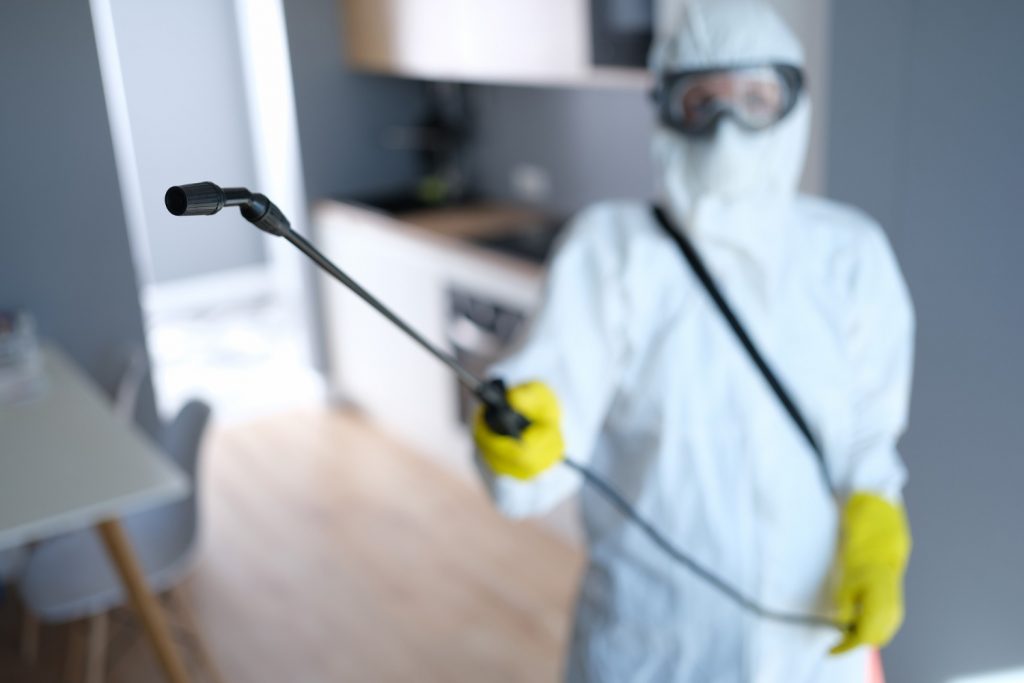
The first step in getting rid of bed bugs on your couch is to identify them. Bed bugs are small, reddish-brown insects that feed on human blood.
They are about the size and shape of an apple seed and can be difficult to spot with the naked eye. However, there are a few telltale signs that you may have a bed bug infestation in your couch.
One way to identify bed bugs is by looking for their fecal matter or blood stains on your furniture’s fabric or cushions. These stains will appear as dark spots or smears and may be accompanied by a musty odor.
Another sign of bed bug infestation is finding shed skins around the area where they hide out during daylight hours – usually cracks, crevices, seams between cushions etc.
Signs of a Bedbug Infestation
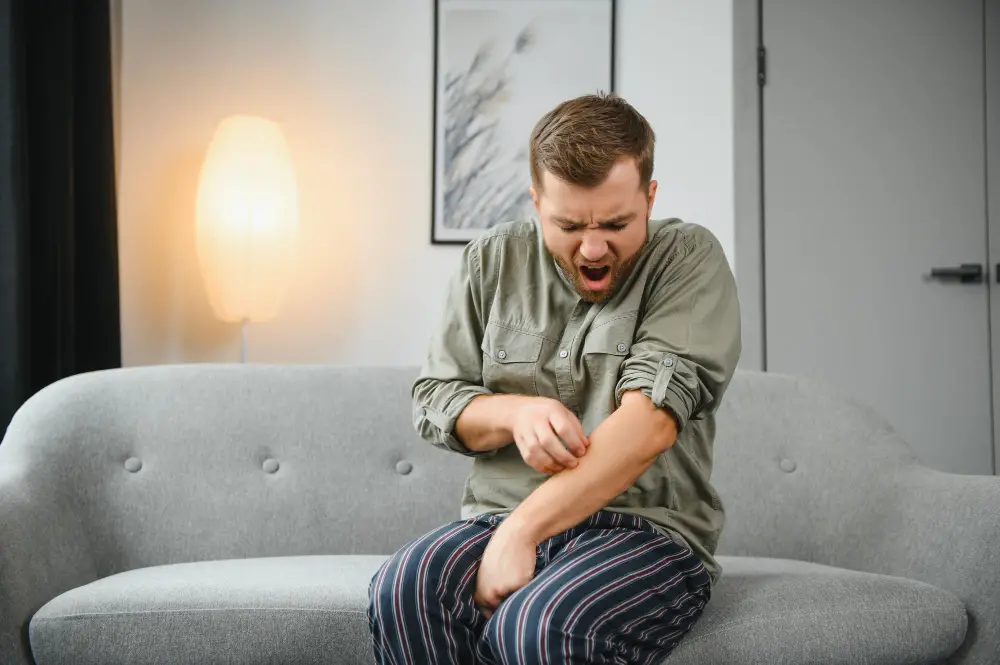
Bed bugs are small, reddish-brown insects that feed on human blood and can be difficult to spot with the naked eye. However, there are several signs that may indicate a bed bug infestation in your couch.
The most obvious sign is seeing live bed bugs crawling around on your furniture. You may also notice tiny white eggs or shed skins left behind by these pests.
Another telltale sign of a bed bug infestation is waking up with itchy bites all over your body after sleeping on the couch. These bites often appear in clusters and can be very uncomfortable.
If you suspect that you have a bed bug problem, it’s important to act quickly before they spread throughout your home.
How to Check for Bed Bugs in a Leather Couch

Bed bugs are small and can be challenging to spot, but there are a few things you can do to identify their presence. Start by examining the seams and crevices of your leather couch thoroughly.
Look for any signs of bed bug activity such as tiny black or brown spots on the surface or in the creases.
Another way to check for bed bugs is by using a flashlight at night when they’re most active. Turn off all lights in the room and shine a bright light on your leather couch while looking closely at its surface.
You may also want to use sticky tape traps designed specifically for catching bed bugs if you have trouble spotting them with just visual inspection alone.
Do Bed Bugs Bite?
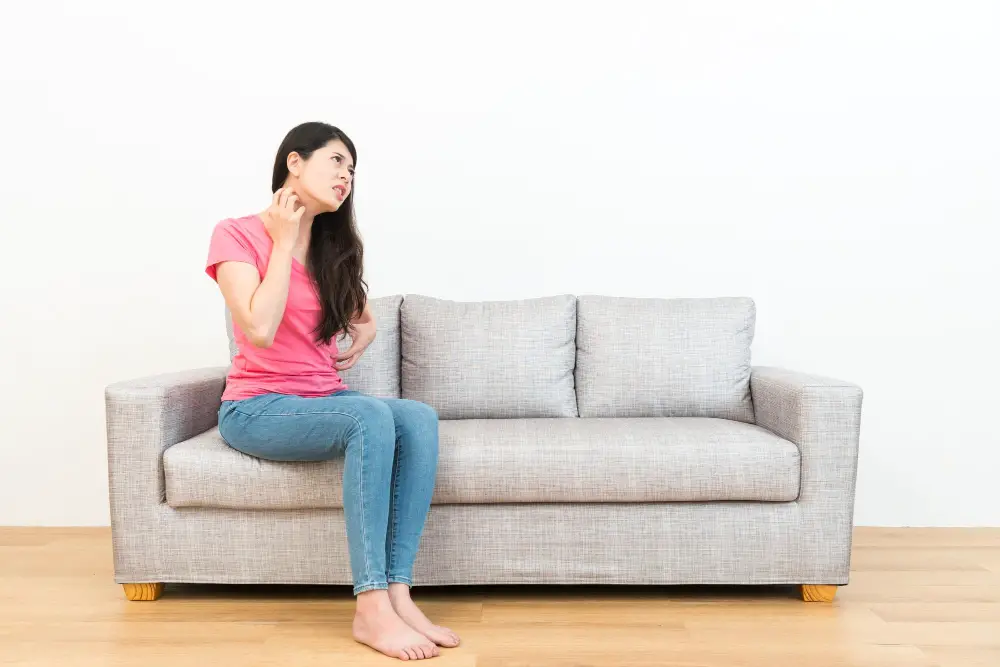
Yes, bed bugs do bite. These tiny pests feed on human blood and can leave itchy, red welts on your skin.
The bites are usually painless at first but may become swollen and itchy later on. It’s important to note that not everyone reacts to bed bug bites in the same way; some people may have no reaction at all.
Bed bugs are most active during the night when you’re asleep, making your couch a prime target for their feeding frenzy. If you wake up with unexplained bites or notice small bloodstains on your sheets or couch cushions, there’s a good chance that bed bugs are present.
It’s essential to take immediate action if you suspect a bed bug infestation in your home as they can quickly spread from one area of furniture to another and even throughout the entire house if left untreated.
Vacuum the Couch Thoroughly
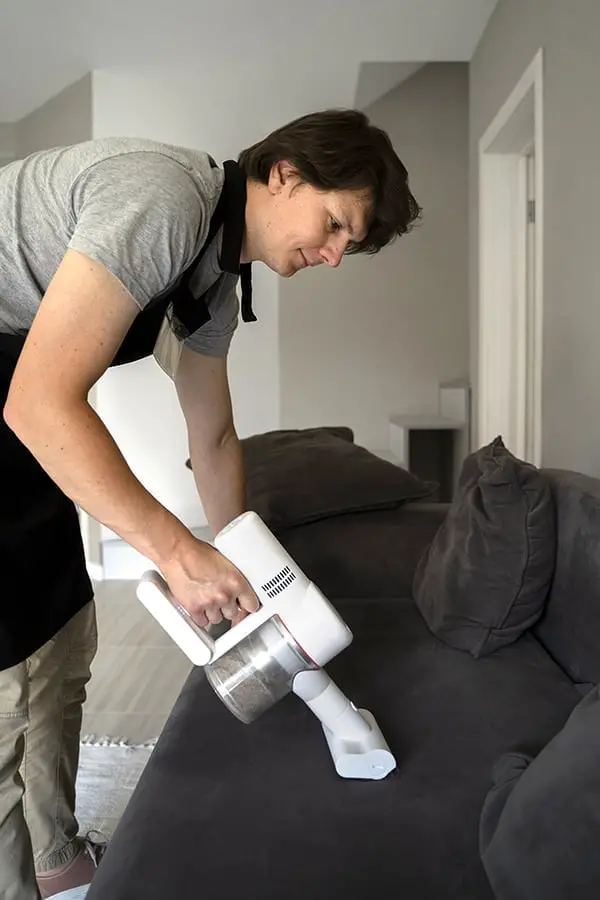
Bed bugs can hide in the crevices and seams of your furniture, so you’ll need to use a vacuum with a crevice tool attachment to reach these areas. Start by removing all cushions and pillows from the couch and using the crevice tool attachment to clean along the seams, edges, and corners of each cushion.
Next, use the upholstery brush attachment on your vacuum cleaner to clean every inch of fabric on both sides of each cushion. Be sure not to miss any spots or leave any gaps where bed bugs could still be hiding.
After cleaning all cushions thoroughly, move onto cleaning other parts such as armrests or backrests that may have been infested with bedbugs too. Vacuum them carefully using both attachments until there are no signs left behind.
Washing and Vacuuming the Couch
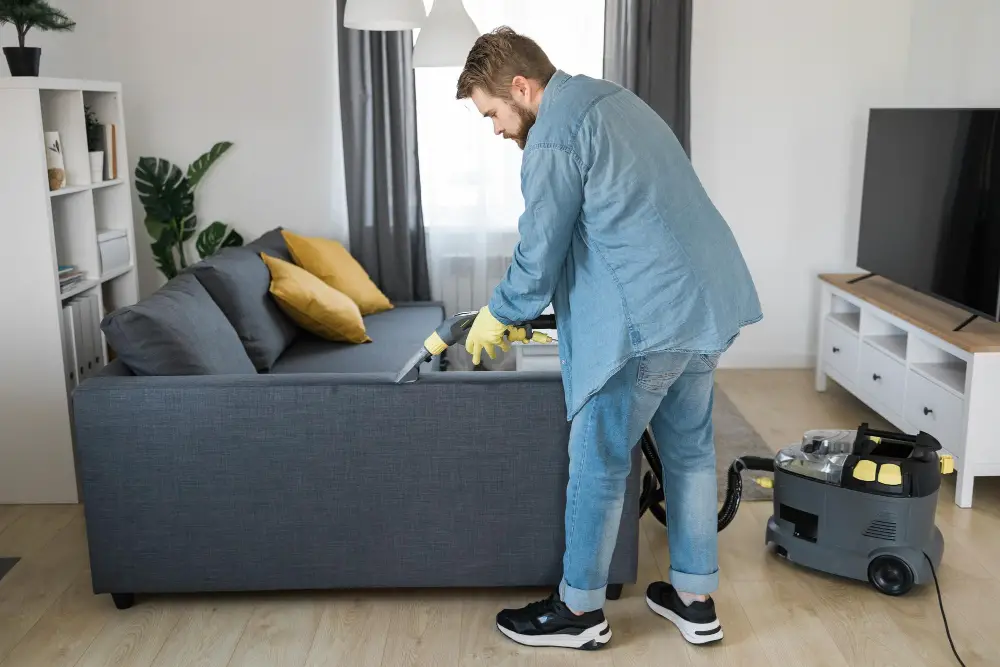
Start by removing all cushions, pillows, and covers from your couch. Place them in a plastic bag or container to prevent any bed bugs from escaping.
Next, use a vacuum cleaner with a crevice tool attachment to clean every nook and cranny of your couch. Pay special attention to seams, folds, tufts, buttons – anywhere that bed bugs could hide.
After you’ve finished vacuuming the entire surface area of your couch (including underneath), it’s time for washing. If possible follow manufacturer’s instructions on how best you can wash or dry-clean each item separately.
For items that cannot be washed such as leather furniture consider using an upholstery cleaner instead which will help remove dirt stains while also killing off any remaining pests hiding within its fibers.
Steam Cleaning the Couch

The high temperature of the steam can penetrate deep into the fabric and kill bed bugs at all stages of their life cycle, including eggs, nymphs, and adults. To use this method, you’ll need a steam cleaner with a hose attachment.
Start by vacuuming your couch thoroughly to remove any loose debris or dust. Then fill up your steam cleaner with water according to the manufacturer’s instructions and turn it on.
Hold the nozzle of the steamer about 1-2 inches away from each section of your couch for at least 30 seconds to ensure that all areas are treated properly. Pay special attention to seams, crevices between cushions or pillows where bedbugs may hide.
After steaming each section carefully wipe down any excess moisture using a clean cloth as dampness can lead to mold growth if left unattended. Repeat this process until you have covered every inch of surface area on both sides (if possible) then let it dry completely before using again.
Using Steam Treatment
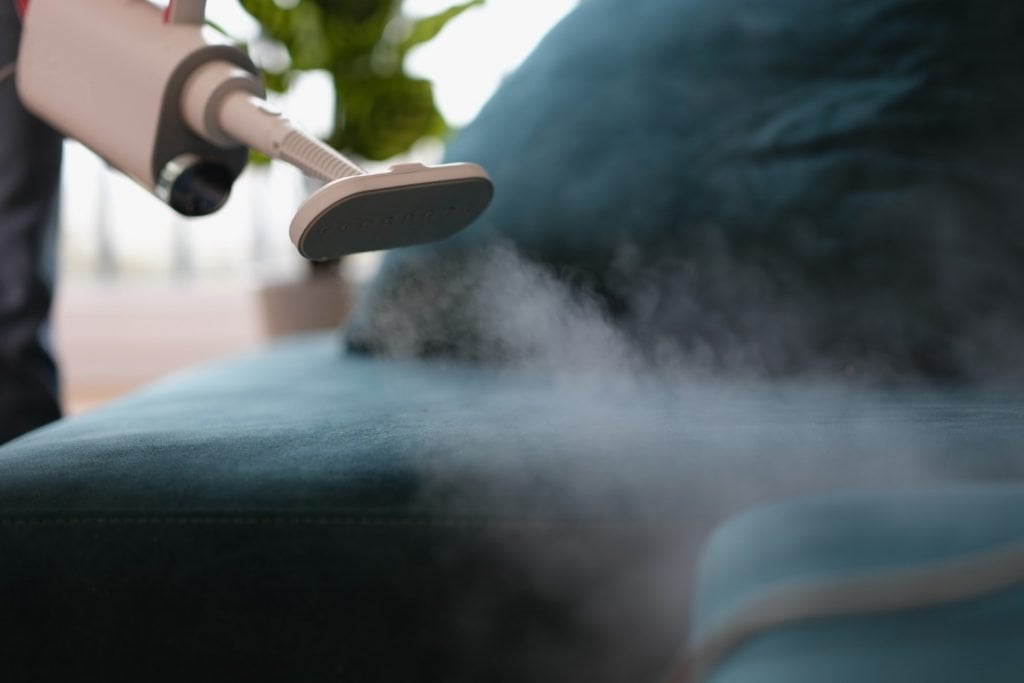
The high temperature of the steam kills bed bugs and their eggs on contact, making it a safe and chemical-free option for those who prefer natural methods.
To use this method, you’ll need a handheld steamer with a nozzle attachment. Start by vacuuming your couch thoroughly to remove any loose debris or dust.
Then, fill the steamer with water and turn it on.
Slowly move the nozzle over every inch of your couch’s surface, paying extra attention to seams and crevices where bed bugs may be hiding. Make sure that you hold the nozzle close enough so that steam can penetrate deep into these areas.
After treating all surfaces of your couch with steam, let it dry completely before using again or covering up with encasements or covers.
Applying Bed Bug Sprays
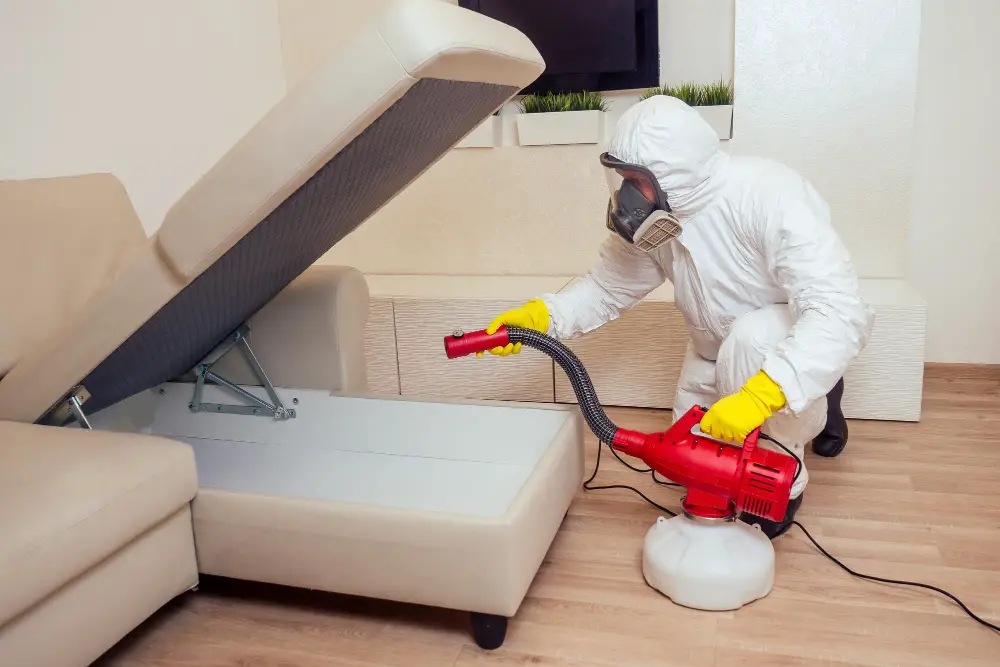
These sprays work by killing the bed bugs on contact, as well as providing residual protection against future infestations. When using a bed bug spray, it’s important to follow the instructions carefully and use it only in areas where you’ve seen evidence of an infestation.
To apply the spray, start by removing all cushions from your couch and vacuuming any visible signs of bed bugs or eggs. Then, shake the canister well before spraying directly onto any cracks or crevices where you suspect there may be hiding spots for these pests.
Be sure to also treat around buttons or seams on upholstered furniture since they provide ideal hiding places for these insects. After applying the spray thoroughly throughout your couch surface area let it dry completely before replacing cushions back into their respective positions.
Diatomaceous Earth Treatment
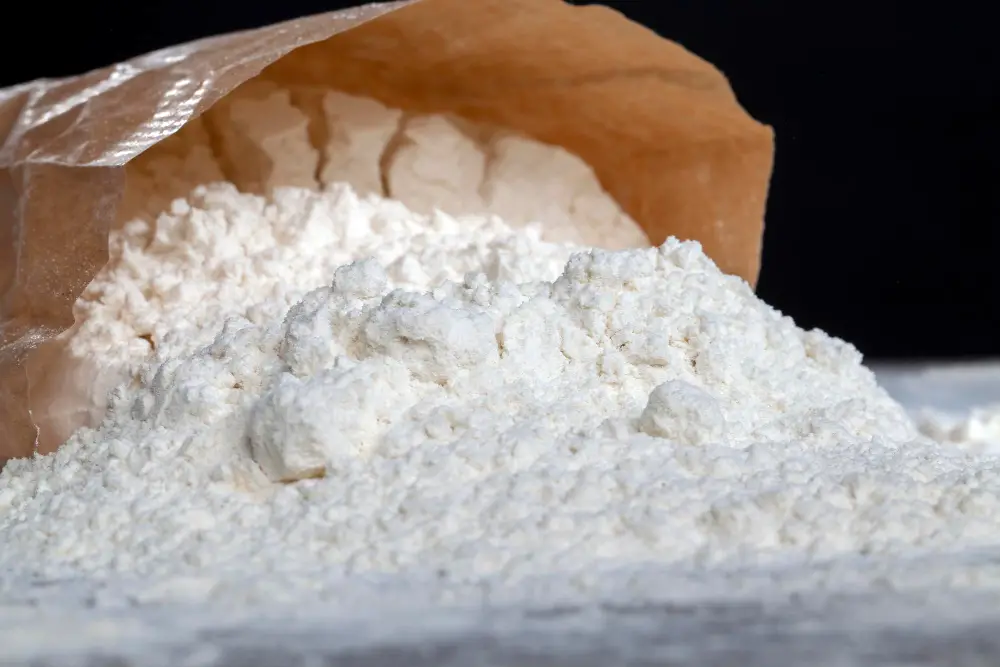
It’s made from the fossilized remains of tiny aquatic organisms called diatoms, which have sharp edges that can cut through the exoskeletons of insects like bed bugs. When applied to your couch, diatomaceous earth will dehydrate and kill any bed bugs it comes into contact with.
To use diatomaceous earth for treating a bed bug infestation on your couch, start by vacuuming the entire surface thoroughly. Then sprinkle a generous amount of food-grade diatomaceous earth over every inch of the furniture piece including crevices and seams where these pests may hide.
Leave it for at least 24 hours before vacuuming again to remove any dead or dying insects along with excess powder residue. Repeat this process until you no longer see signs or evidence that there are still living pests present in your sofa.
Applying Chemical Treatment
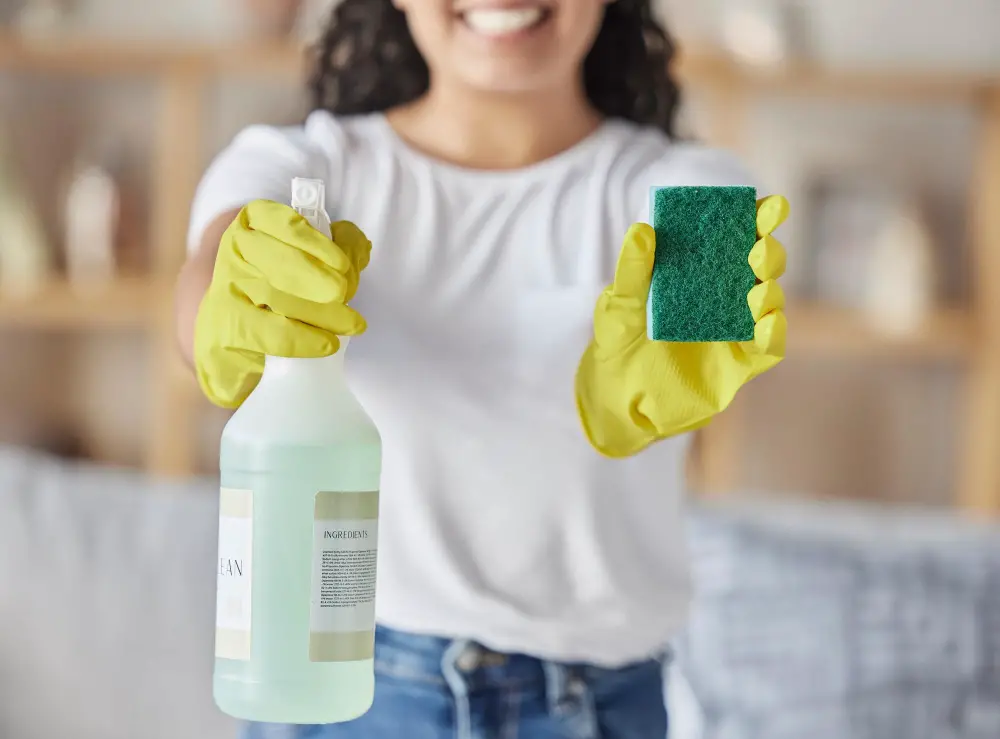
There are several types of insecticides available that can effectively kill bed bugs on contact. However, it’s important to use these chemicals with caution and follow the instructions carefully.
Before applying any chemical treatment to your couch, make sure to vacuum it thoroughly and remove all cushions and pillows. Then apply the insecticide directly onto the affected areas of your couch according to the manufacturer’s instructions.
It’s essential not only to treat visible signs of infestation but also hidden areas where bed bugs might be hiding such as crevices or seams in furniture upholstery.
After applying a chemical treatment, leave your home for at least 4 hours before returning so that any fumes can dissipate completely. Once you return home after this period has elapsed open windows for ventilation purposes until there is no more smell from chemicals used during extermination process.
Installing Bed Bug Interceptors
These devices work by trapping bed bugs as they try to climb up the legs of your furniture, preventing them from reaching you or your family. Installing bed bug interceptors is easy and can be done in just a few minutes.
To install an interceptor, simply place it under each leg of your couch. Make sure that the legs fit snugly into the center well of the interceptor so that any crawling insects will fall into it and get trapped inside.
Interceptors come in different sizes and shapes, so make sure you choose one that fits perfectly with your couch’s leg size. You can also use double-sided tape around each leg before placing an interceptor for added protection against these pesky pests.
Couch Encasements
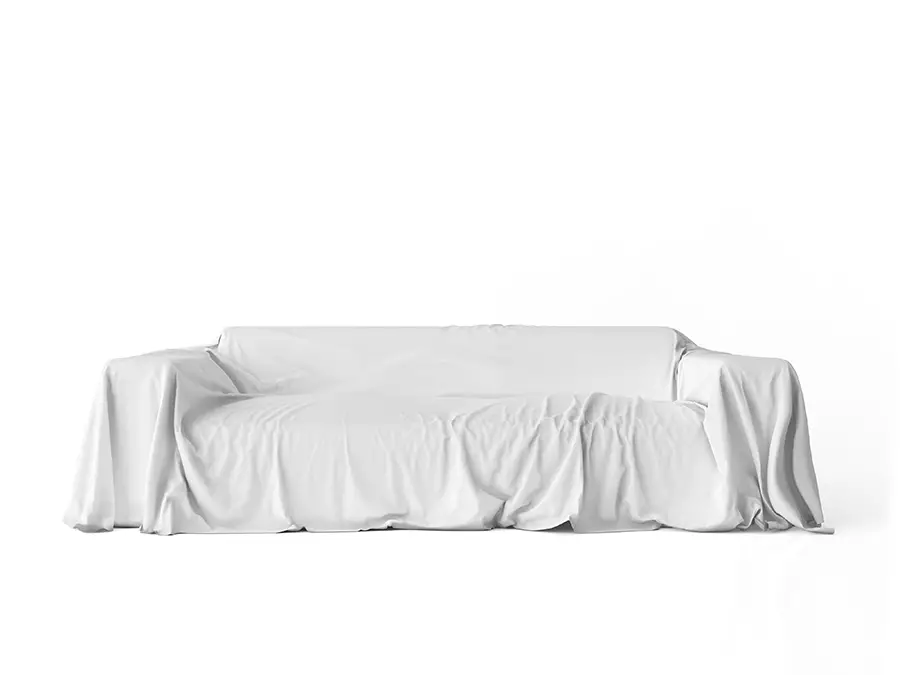
These encasements are specially designed covers that completely seal off your couch, preventing any bed bugs from getting in or out. They’re made of durable materials and can withstand regular use without tearing or ripping.
To use a couch encasement, simply remove all the cushions and slip the cover over the entire piece of furniture. Make sure it’s snugly fitted around every corner and crevice so there’s no room for bed bugs to sneak in.
One advantage of using a couch encasement is that it makes cleaning much easier since you only need to wipe down the surface instead of vacuuming every inch. Plus, if you ever do have another infestation, you’ll be able to spot them more easily on top of the cover rather than hidden inside your furniture.
Launder Couch Cushion Covers

Bed bugs can hide in the seams and folds of cushion covers, so washing them in hot water is an effective way to kill any remaining bugs and their eggs.
To launder the cushion covers:
- Remove all cushions from the couch.
- Check each cover for signs of bed bugs or eggs.
- Place each cover into a large plastic bag.
- Take the bags directly to your washing machine and dump out contents without shaking or handling too much
- Wash on high heat (at least 120°F) for at least 30 minutes with detergent
- Tumble dry on high heat until completely dry
After laundering, inspect each cover again before putting it back onto its respective pillow insert.
Cleaning Throw Pillows
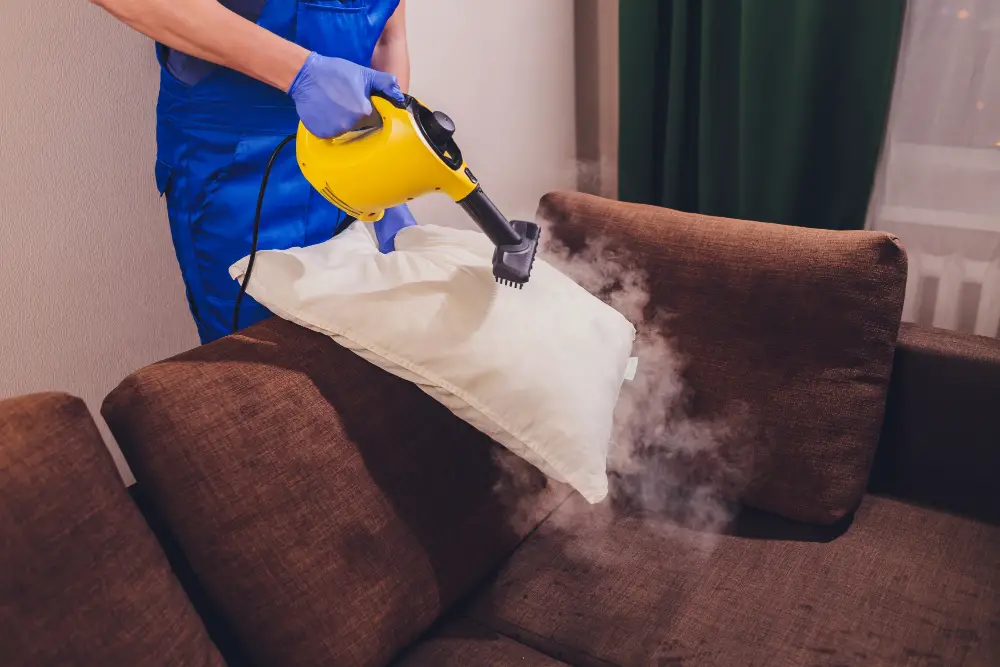
To clean throw pillows, start by removing the covers and washing them in hot water. Be sure to dry them on high heat as well.
For the pillow inserts themselves, you have a few options. If they’re machine washable, follow the same steps as with the covers.
If not, you can try vacuuming them thoroughly or placing them in a plastic bag and freezing them for several days (this will kill any bed bugs).
It’s important to note that if your throw pillows are infested with bed bugs, it’s likely that other areas of your home are too. Be sure to take all necessary precautions when cleaning and treating your couch and surrounding areas.
Can Bed Bugs Infest Other Types of Furniture?

They can easily hide in the seams and crevices of chairs, recliners, ottomans, and even mattresses. In fact, bed bugs got their name because they were commonly found in beds.
If you have a bed bug infestation in your home or apartment building, it’s important to inspect all types of furniture thoroughly. Bed bugs can travel from one piece of furniture to another through walls or electrical outlets.
To prevent further spread of bed bugs throughout your home or building complex:
- Inspect all other pieces of upholstered furniture
- Check wooden chairs and tables for cracks where bedbugs could hide
- Look under rugs that may be covering hardwood floors
- Examine curtains near the infected area
Remember that early detection is key when dealing with a potential infestation.
Professional Extermination
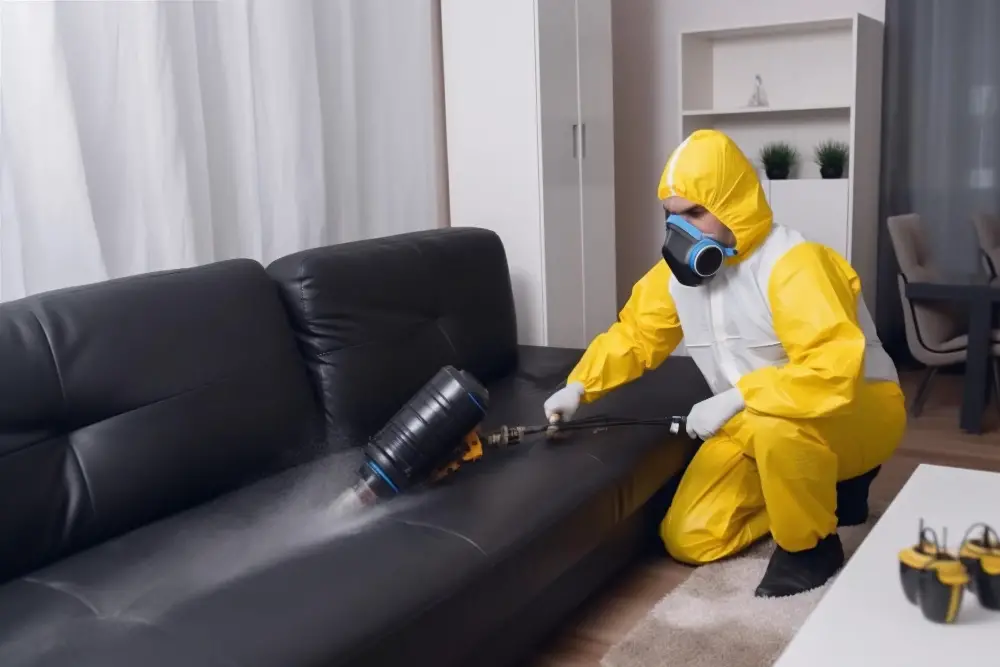
A licensed pest control company has access to specialized equipment and chemicals that are more effective than what’s available over-the-counter. They also have experience dealing with bed bug infestations, so they know exactly where to look for these pests.
Professional extermination is a more expensive option compared to DIY methods, but it’s often worth the investment if you want a guaranteed solution. The cost will depend on several factors such as the severity of your infestation and how much furniture needs treatment.
When hiring a professional exterminator, make sure they’re licensed by your state or local government agency responsible for regulating pest control companies. Also ask about their experience treating bed bugs specifically since not all companies specialize in this type of service.
Once you’ve hired an exterminator, follow their instructions carefully before and after treatment. This includes preparing your home by removing clutter from around furniture items like couches so that technicians can easily access them during treatment sessions.
Professional Bed Bug Pest Control Services
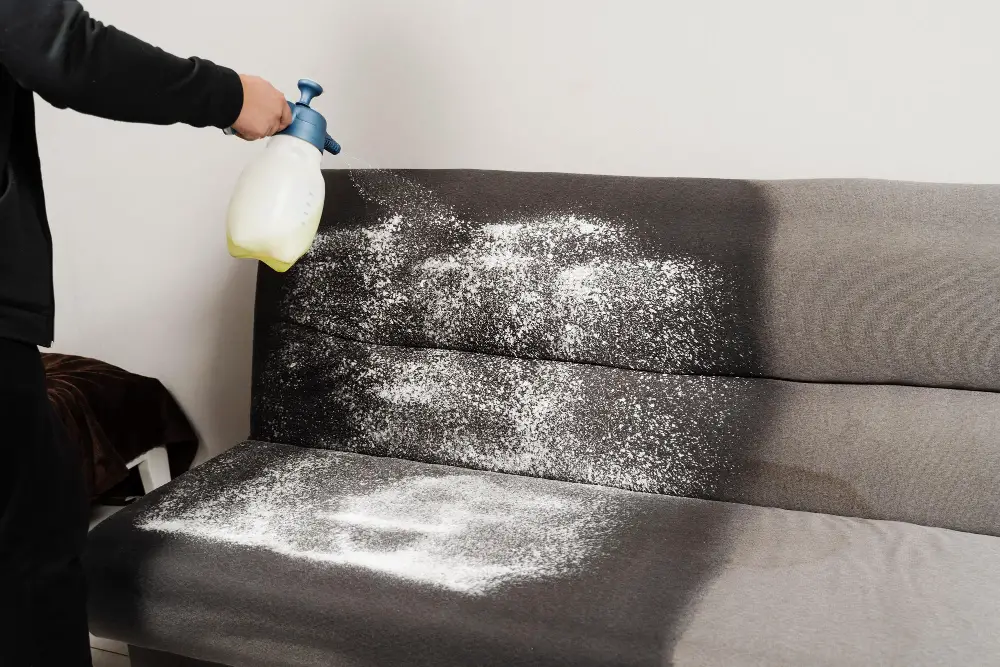
Bed bug pest control services have access to specialized equipment and chemicals that are more effective than what’s available over-the-counter. They also have experience dealing with bed bug infestations, so they know exactly where to look for these pests.
Professional exterminators will typically start by inspecting your couch thoroughly for signs of bed bugs. Once they’ve confirmed an infestation, they’ll use a combination of treatments such as heat treatment or chemical sprays depending on the severity of the problem.
While professional pest control services can be expensive, it’s often worth it if you’re dealing with a severe infestation or if other DIY methods haven’t worked. Plus, many companies offer warranties or guarantees on their work which means that if any bed bugs return within a certain period after treatment is completed then they will come back out at no additional cost.
Preventing Future Infestations
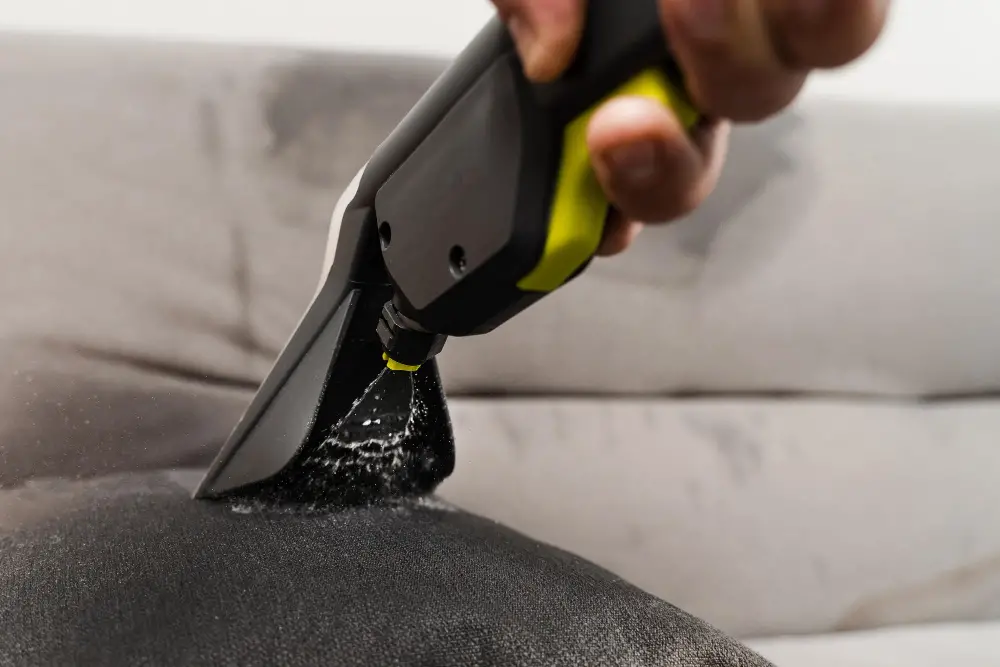
Here are some tips for preventing future infestations:
1. Regularly vacuum and clean your couch: Bed bugs can easily hide in the crevices of furniture, so it’s essential to keep your couch clean and free of clutter.
2. Use a protective cover: Consider using a bed bug-proof encasement on your couch cushions or an intercepting device under the legs of the sofa.
3. Inspect second-hand furniture before bringing it home: If you’re buying used furniture, be sure to inspect it thoroughly for any signs of bed bugs before bringing it into your home.
4. Be cautious when traveling: Bed bugs can hitchhike on luggage or clothing while traveling, so be sure to inspect hotel rooms carefully and wash all clothing immediately upon returning home.
Regular Maintenance Tips
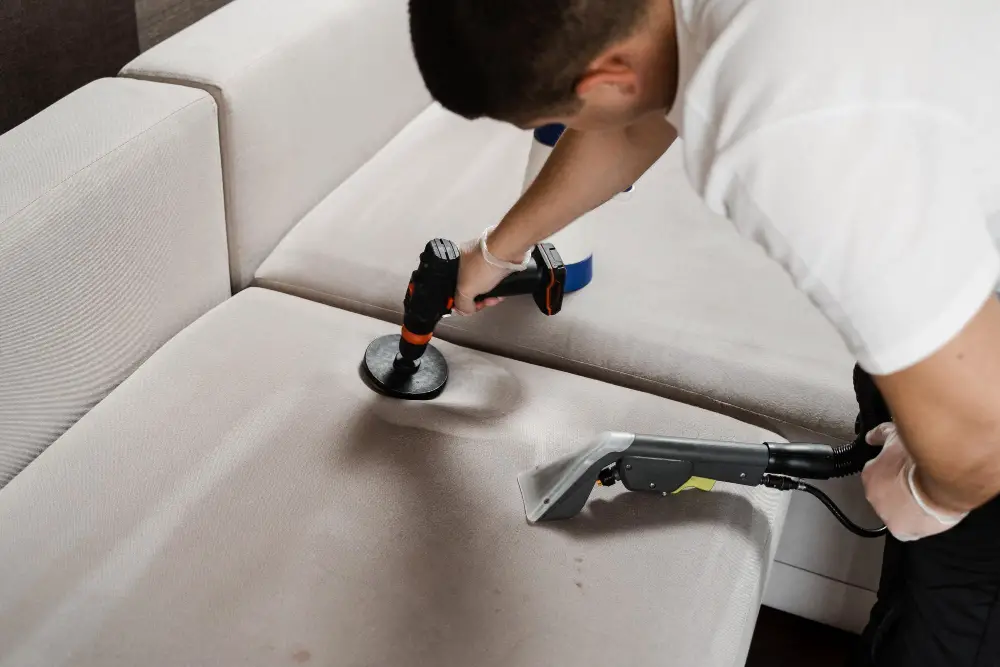
Here are some regular maintenance tips that can help keep your couch and home bug-free:
1. Vacuum regularly: Regular vacuuming of the couch and surrounding areas can help remove any stray bed bugs or eggs that may have been missed during treatment.
2. Inspect second-hand furniture: If you’re considering purchasing used furniture, be sure to inspect it thoroughly for signs of bed bugs before bringing it into your home.
3. Keep clutter at bay: Cluttered spaces provide hiding places for bed bugs, so keeping a tidy living space is essential in preventing infestations.
4. Wash bedding frequently: Bedding should be washed on a weekly basis in hot water (at least 130°F) to kill any potential pests or eggs.
5. Use mattress encasements: Mattress encasements can protect against future infestations by trapping any remaining pests inside the cover where they will eventually die off without access to food sources.
By following these simple maintenance tips, you’ll greatly reduce the risk of another frustrating encounter with these pesky insects!
FAQ
How long can bed bugs live in a couch?
Bed bugs can live in a couch for up to 4.5 months without a host under optimal conditions of heat and humidity.
How can you tell if a couch has bed bugs?
To determine if a couch has bed bugs, search for small black dot-like droppings near seams, underneath, or within nooks and crannies of the furniture.
What instantly kills bed bugs?
Rubbing alcohol instantly kills bed bugs when diluted and sprayed on infested areas.
What causes bed bugs in a couch?
Bed bugs in a couch can be caused by infestations from other areas, used furniture, or hitching a ride on personal items like luggage or backpacks placed on soft surfaces, or even from nearby rooms in multi-unit buildings.
What are the effective home remedies for treating bed bugs in a couch?
Effective home remedies for treating bed bugs in a couch include using diatomaceous earth, vacuuming, and applying heat by using a steamer or dryer.
How can you prevent bed bugs from infesting your couch in the future?
To prevent bed bugs from infesting your couch in the future, ensure regular cleaning, use protective encasements, and avoid bringing in second-hand furniture.
Can professional exterminators guarantee complete removal of bed bugs from a couch?
Although professional exterminators can significantly reduce the number of bed bugs in a couch, they cannot guarantee complete removal of all bed bugs.




